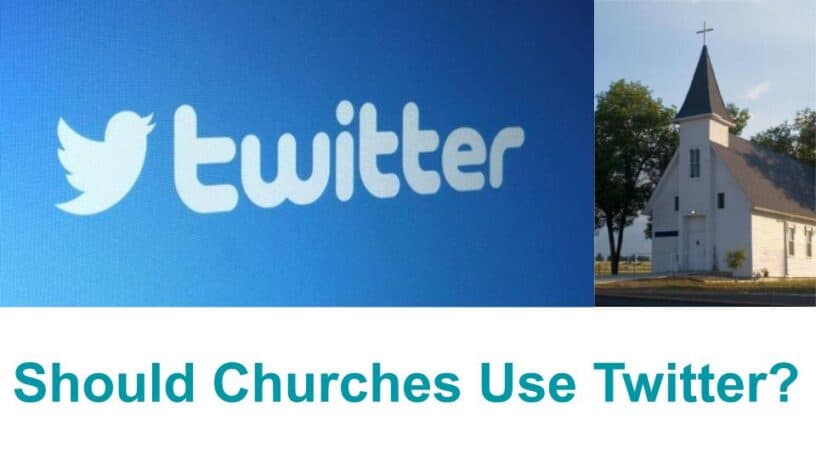Several of the churches I’ve worked with ask about Social Media like Twitter but don’t use it because they don’t have a clear strategy for why they are using it. This post will help you decide if your church (or non-profit) should be using Twitter.
So, should churches use Twitter? Yes, Twitter can be a great tool to get information out very quickly – as long as you use it in the right way. It works best if an organization focuses on pushing information instead of interacting with users who follow the church’s Twitter account.
I hedged a bit by clarifying that a church has to use it in the “right way.” There are a few caveats to consider that will make a church’s Twitter usage productive, meaningful…and safe.
Focus on pushing content like Verses and Upcoming Events
The Internet is filled to the brim with anonymous people that have opinions. A LOT of opinions. Sometimes, a LOT of AWFUL opinions. That’s normal and expected.
When a church tweets out a Verse-of-the-Day or a reminder about the next potluck, avoid responding to anyone that might reply to the tweet with malicious comments or off-topic opinions. You can and should – within reason – read replies if they have helpful feedback, but do NOT engage in debates or arguments about the accuracy of the Book of James, for example. It’s a huge time waster and increases the probability that a grammatical error will be misinterpreted and mistakenly cast your church’s position on a topic in a bad light.
Remember, push only. Do NOT engage unless the reply is constructive. It’s way too easy to get sucked into a rabbit hole that won’t serve you or your church.
Avoid Liking or Retweeting political or controversial tweets from others
The person in your organization responsible for managing your Twitter account needs to stay laser focused on only posting what is directly relevant to your church and your church’s mission. Liking and retweeting posts from other accounts is commonly interpreted as an endorsement of that other account’s opinion.
Unless you’re 100% sure the liked or retweeted tweet is in perfect alignment with your church’s values or is completely generic enough to not be construed as a endorsement of a sensitive topic, avoid it.
Likewise, a tweet on a sensitive topic tends to attract trolls and the overly opinionated. Even if the content IS in alignment with your church’s mission and values, take a moment to also consider the reputation of the original author. As with any content, check the source carefully.
Develop a publishing schedule
A “publishing cycle” can seem like a daunting thing if you’ve never done one before, but it’s really nothing more than a few reminders on a calendar. Whether it’s tweets or Facebook posts, or any other form of social media content, your message will get lost in the noise of everything your subscriber is receiving all at the same time on any given day. However, if you tweet your message(s) regularly and consistently, you greatly increase the probability your tweet will be seen.
For the higher priority stuff…for example, let’s say you have an upcoming charity auction and you need to get as many people to show up as possible…tweet and retweet as often as you can without getting ‘spammy.’
What’s ‘spammy?’ Multiple retweets per hour for the same event reminder is way too much. One retweet for the same event reminder every 3-4 hours is typically about right to maximize exposure.
Check your analytics to see what resonates
This is not really going back on what I said earlier regarding “push only.” This is about understanding how effective your tweets are. Are they reaching the right people? Are they getting shared (retweeted)? Are they engaging your subscribers to help spread your message?
Let’s say you’re tweeting out daily on key verses that support your last Sunday’s sermon on Exodus as encouragement to folks that are going about their day. When you enable analytics in your Twitter account, you might find more replies, likes, and retweets for one specific tweet that references one specific verse.
That could be interpreted as your subscribers are feeling a spiritual need to hear about that specific verse as it applies to whatever is going on in their life right now. That’s useful information for a church to understand what messages would be most meaningful for your attenders and life group members in the following weeks. It’s near real-time feedback that highlights the present needs of the congregation.
Take advantage of Surveys
Most social platforms like Twitter and Facebook have a survey feature to ask subscribers for input on an assortment of topics. For your church or non-profit, it’s extremely useful to quickly ask your followers for input.
Here’s an example…
Let’s say you’re planning your next charity dinner and you’re trying to make a decision about the meal choices that would be most appealing to attenders. Use the survey function in Twitter to list out your options for immediate feedback. Ensuring your serve food that suits the majority.
How about another example…
Let’s say your organizing a clothing drive for needy families heading into Winter weather, but you don’t know for sure what’s needed most – coats, gloves, or boots. You can quickly tweet out a survey to all followers who are either families in need or followers who know a family in need and get that feedback right away. Powerful stuff.
Connect your Twitter account with other Social Platforms
Last but definitely not least, choosing Twitter to reach your followers doesn’t have to be another thing you have to stack on to your existing duties…if you set it up right. Most of the social platforms like Facebook, LinkedIn, Twitter, and Instagram have an option to connect with each other . When these connections are set up, posting to one automatically posts to all – extending your reach much farther than you could on any one platform.
The setup to connect accounts is best handled by somebody in your organization with technical skills, but once it’s done, it’s done.
I hope this article has been helpful for you. Feel free to reach out with any questions to [email protected] .
Related Questions
Is it okay to post pictures on Twitter? Yes, as long as you have permission from the folks in the picture to post it. If not, you can risk privacy violations. Getting permission is doubly important if the photo has children in it. Make sure to ask their parents first.
Who should run the Twitter account? That depends on the communication responsibilities of your church. Often, the pastor will write the messages but the tweets are directly posted by a church secretary or (if you have one) a communications director.


